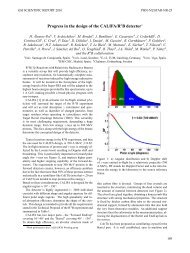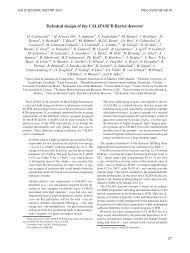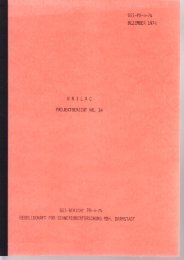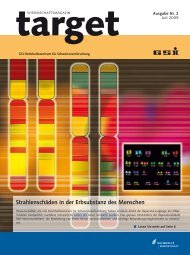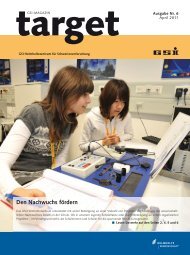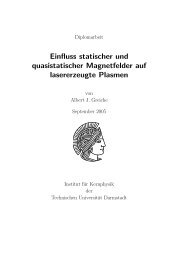download block - GSI Helmholtzzentrum für Schwerionenforschung
download block - GSI Helmholtzzentrum für Schwerionenforschung
download block - GSI Helmholtzzentrum für Schwerionenforschung
Create successful ePaper yourself
Turn your PDF publications into a flip-book with our unique Google optimized e-Paper software.
<strong>GSI</strong>-ACCELERATORS-04 <strong>GSI</strong> SCIENTIFIC REPORT 2009<br />
UNILAC Status and Developments<br />
W. Barth, L. Dahl, P. Gerhard, L. Groening, M. Maier, S. Mickat, M.S. Kaiser, H. Vormann,<br />
S. Yaramishev, <strong>GSI</strong>, Darmstadt, Germany<br />
.<br />
Status of Operation<br />
For further biology experiments under therapy conditions<br />
a carbon beam from the Electron Cyclotron Resonance<br />
(ECR) ion source was accelerated via the high charge<br />
state injector (HLI) in the UNILAC for the SIS-injection<br />
(2 weeks) [1]. Additionally UNILAC experiments used<br />
the beam from the HLI with a duty factor of up to 30 %.<br />
Furthermore the ECR source was in operation for the production<br />
of various isotopes (3H, 6 Li, 7 Li, 34 S, 48 Ca, 54 Cr,<br />
122 Sn, 124 Sn, 136 Xe) as well. During a four weeks <strong>block</strong><br />
with sulphur beam and a two weeks <strong>block</strong> of chromium<br />
beam at the beginning of 2009 experiments for the Super<br />
Heavy Element synthesis (SHE) were supplied. Besides<br />
48 Ca was used for two weeks at the SHIPTRAP. Dominantly<br />
during two long runs of six weeks 48 Ca-beam could<br />
be delivered to the TASCA-Separator for chemistry experiments.<br />
Additionally ion beams with different Zinc<br />
isotopes were used for the UNILAC-experiment X7 at<br />
low beam energy. The ECR-beam (3H, 6 Li, 7 Li) was also<br />
injected into the SIS 18 for high energy fixed target experiments<br />
as well as for ESR-experiments. The Penning<br />
(PIG) ion source provided 40 Ar, 56 Fe, 58 Ni, 96 Ru, 136 Xe,<br />
197 Au and 238 U beams with medium intensity, especially<br />
for high duty factor experiments with heavy ions at<br />
UNILAC-beam energies. Mainly the heavy ions were<br />
delivered especially for the material research experiments<br />
at the new M-branch and at X0. Light ions as well as<br />
heavy ions from the PIG were accelerated via High Current<br />
Injector (HSI) in the UNILAC with short pulses for<br />
the SIS 18. The MUlti Cusp Ion Source (MUCIS) provided<br />
beams for different high-energy experiments with<br />
high intensities (H2, 40 Ar). The Metal Vapour Vacuum<br />
Arc (MEVVA) ion source delivered 181 Ta and 238 U beams<br />
for SIS-injection. After a long time of absence the<br />
UNILAC was in operation for five weeks for uranium<br />
machine studies as well as for a week <strong>block</strong> of regular<br />
uranium beam experiments. Heavy ion machine experiments<br />
in preparation for the UNILAC as an injector for<br />
FAIR were performed additionally with tantalum (medium<br />
intensity) and high current argon beams.<br />
Shutdown Working<br />
During shutdown time new power supplies for the Alvarez<br />
2a, 2b, 3 and 4 inner tank quadrupoles were installed,<br />
enabling stronger beam focussing in the whole poststripper<br />
section. The Alvarez tank revision program starting in<br />
the winter shutdown 08/09 was finished for tank no. 1.<br />
Furthermore an advanced chemical rinsing procedure was<br />
successfully tested and applied for the cooling system of<br />
the drift tubes and tank mantle of ALVAREZ 1 and 2, due<br />
to a critical occlusions with ferric oxide particles. The<br />
132<br />
chemical rinsing will be extended to the other tanks in the<br />
next years. The defective cooling resulted in a overheating<br />
of one A3-drift tube and its quadrupole. Accordingly<br />
after a long time of beam operation with limited duty factor<br />
and reduced focussing strength, a new drift tube was<br />
successfully installed in the wintershutdown 09/10. Design<br />
and fabrication of the drift tube and the quadrupole<br />
was completely accomplished in the <strong>GSI</strong>-workshops. Additionally<br />
another three defective tank quads inside AL-<br />
VAREZ were detected. An advanced repair program is<br />
already scheduled. But for all that the UNILAC operated<br />
with high reliability. [1]<br />
UNILAC-Upgrade Measures<br />
Fig. 1: The new RFQ for the HLI (left) and the HSI-RFQ<br />
with newly installed electrodes (right).<br />
Different UNILAC-upgrade projects were planned and<br />
accomplished in essence:<br />
- HSI-RFQ-Upgrade for FAIR [2]<br />
- Preparation of the HSI-LEBT-Upgrade for FAIR [2]<br />
- Beam investigations at the High Current Test Bench<br />
with a sc-solenoid<br />
- High Current beam diagnostics for the FAIR-UNILAC-<br />
Upgrade: Mounting of additional BIF-stations in the<br />
UNILAC and the transfer line to the SIS18<br />
- Commissioning of a 8 kW-rf-amplifier prototype and<br />
the first delivery of the batch fabrication<br />
- HLI-RFQ-Upgrade [3]<br />
Machine Experiments<br />
11 days of machine experiments were performed with an<br />
high current argon beam mainly for commissioning of the<br />
upgraded HSI-RFQ. Two days with a tantalium beam and<br />
one days with uranium beam were accomplished for recommissioning<br />
of the UNILAC with low charged heavy<br />
ion beams from the MeVVa-ion source. Finally in december<br />
the ECR ion source delivered argon beam for one<br />
week of experiments in the HLI-LEBT in preparation of<br />
the HLI-RFQ-upgrade [3].<br />
References<br />
[1] U. Scheeler et. al., Accelerator Operation Report, (this report)<br />
[2] H. Vormann, et. al., HSI Frontend-Upgrade, (this report)<br />
[3] P. Gerhard, et. al., Status of the HLI-RFQ-Upgrade (this report)





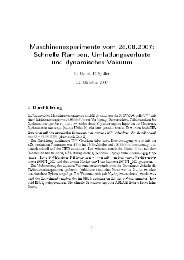
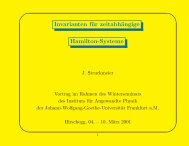
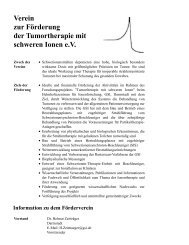
![GS I -P-]-17 - GSI Helmholtzzentrum für Schwerionenforschung](https://img.yumpu.com/20698964/1/184x260/gs-i-p-17-gsi-helmholtzzentrum-fur-schwerionenforschung.jpg?quality=85)

